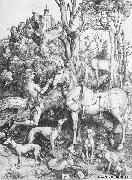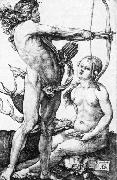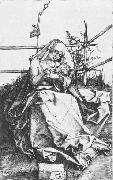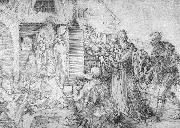All Albrecht Durer Oil Paintingsb.May 21, 1471, Imperial Free City of N??rnberg [Germany] d.April 6, 1528, N??rnberg |
|||
 |
|||
|
|
|
||||||||||
|
|
||||||||||
|
St Eustace Gemälde IDENTIFIZIERUNG:: 63579 |
St Eustace 1501 Engraving, 355 x 259 mm Fogg Art Museum, Cambridge The print is often erroneously called "St Hubert." This is D?rer's largest single-leaf copper engraving. He frequently sold impressions of it or gave them away as presents during his journey to the Netherlands. The legend of St Eustace is narrated in the Legenda aurea and is freely adapted in D?rer's picture. The Roman officer Placidus was converted to Christianity by a vision of a stag who spoke with the voice of Christ and carried a crucifix in its antlers, and he then took the name of Eustace. Here, the scene is taking place in the middle of a forest landscape, next to a pond. The statue-like depiction of the horse and the greyhounds, which are shown in five different body positions, shows that D?rer was more interested in reproducing proportions than in creating a precisely detailed account of the Christian legend. D?rer carefully avoided any overlapping of the animals. In this end and other details this print is closely related to Pisanello's painting of the same subject (National Gallery, London). The unusually large size of the plate appears to have caused some difficulty in printing. Even some of the best impressions have some squeezed lines near the edges. There are impressions on satin, all posthumous, at Coburg, Boston, Vienna, Gotha and Frankfurt.Artist:D?RER, Albrecht Title: St Eustace Painted in 1501-1550 , German - - graphics : religious 1501 Engraving, 355 x 259 mm Fogg Art Museum, Cambridge The print is often erroneously called "St Hubert." This is D?rer's largest single-leaf copper engraving. He frequently sold impressions of it or gave them away as presents during his journey to the Netherlands. The legend of St Eustace is narrated in the Legenda aurea and is freely adapted in D?rer's picture. The Roman officer Placidus was converted to Christianity by a vision of a stag who spoke with the voice of Christ and carried a crucifix in its antlers, and he then took the name of Eustace. Here, the scene is taking place in the middle of a forest landscape, next to a pond. The statue-like depiction of the horse and the greyhounds, which are shown in five different body positions, shows that D?rer was more interested in reproducing proportions than in creating a precisely detailed account of the Christian legend. D?rer carefully avoided any overlapping of the animals. In this end and other details this print is closely related to Pisanello's painting of the same subject (National Gallery, London). The unusually large size of the plate appears to have caused some difficulty in printing. Even some of the best impressions have some squeezed lines near the edges. There are impressions on satin, all posthumous, at Coburg, Boston, Vienna, Gotha and Frankfurt.Artist:D?RER, Albrecht Title: St Eustace Painted in 1501-1550 , German - - graphics : religious |
|||||||||
|
|
||||||||||
|
|
Apollo and Diana Gemälde IDENTIFIZIERUNG:: 63581 |
Apollo and Diana 1502 Engraving, 115 x 70 mm Metropolitan Museum of Art, New York Closely related to the very similar engraving by Jacopo de Barbari. In no other plate, except Adam and Eve is there such delicate modelling of the flesh. The contrast of male and female is emphasized by the introduction of movement. The head of Diana is almost identical to the one in the drawing Woman Riding a Dolphin, dated 1503. The D of the monogram shows a correction.Artist:D?RER, Albrecht Title: Apollo and Diana Painted in 1501-1550 , German - - graphics : mythological 1502 Engraving, 115 x 70 mm Metropolitan Museum of Art, New York Closely related to the very similar engraving by Jacopo de Barbari. In no other plate, except Adam and Eve is there such delicate modelling of the flesh. The contrast of male and female is emphasized by the introduction of movement. The head of Diana is almost identical to the one in the drawing Woman Riding a Dolphin, dated 1503. The D of the monogram shows a correction.Artist:D?RER, Albrecht Title: Apollo and Diana Painted in 1501-1550 , German - - graphics : mythological |
||||||||
|
|
||||||||||
|
|
Madonna on a Grassy Bench Gemälde IDENTIFIZIERUNG:: 63582 |
Madonna on a Grassy Bench 1503 Engraving, 115 x 70 mm Fogg Art Museum, Cambridge Except for The Four Witches, this is the first of D?rer's engravings to bear a date. Henceforth he dated them consistently. Vasari remarks that D?rer here "surpassed Martin Schongauer, as well as himself." This engraving, based on a preparatory drawing, is the most sensitive of the early Madonnas, quite in the convivial style of the Life of the Virgin woodcut series.Artist:D?RER, Albrecht Title: Madonna on a Grassy Bench Painted in 1501-1550 , German - - graphics : religious 1503 Engraving, 115 x 70 mm Fogg Art Museum, Cambridge Except for The Four Witches, this is the first of D?rer's engravings to bear a date. Henceforth he dated them consistently. Vasari remarks that D?rer here "surpassed Martin Schongauer, as well as himself." This engraving, based on a preparatory drawing, is the most sensitive of the early Madonnas, quite in the convivial style of the Life of the Virgin woodcut series.Artist:D?RER, Albrecht Title: Madonna on a Grassy Bench Painted in 1501-1550 , German - - graphics : religious |
||||||||
|
|
||||||||||
|
|
The Adoration Gemälde IDENTIFIZIERUNG:: 63583 |
The Adoration 1524 Pen, 215 x 294 mm Graphische Sammlung Albertina, Vienna Perhaps this is a study for the introductory piece of the last, uncompleted, Passion woodcut series. The nobility of the composition is combined with a truly radiant beauty of line.Artist:D?RER, Albrecht Title: The Adoration of the Wise Man Painted in 1501-1550 , German - - graphics : study 1524 Pen, 215 x 294 mm Graphische Sammlung Albertina, Vienna Perhaps this is a study for the introductory piece of the last, uncompleted, Passion woodcut series. The nobility of the composition is combined with a truly radiant beauty of line.Artist:D?RER, Albrecht Title: The Adoration of the Wise Man Painted in 1501-1550 , German - - graphics : study |
||||||||
|
|
||||||||||
| VORHERIGER KÜNSTLER NÄCHSTER KÜNSTLER | ||||||||||
|
|
||||||||||
| Albrecht Durer | ||||||||||
| b.May 21, 1471, Imperial Free City of N??rnberg [Germany] d.April 6, 1528, N??rnberg | ||||||||||
|
|
||||||||||
|
KONTAKTIEREN Sie UNS |









